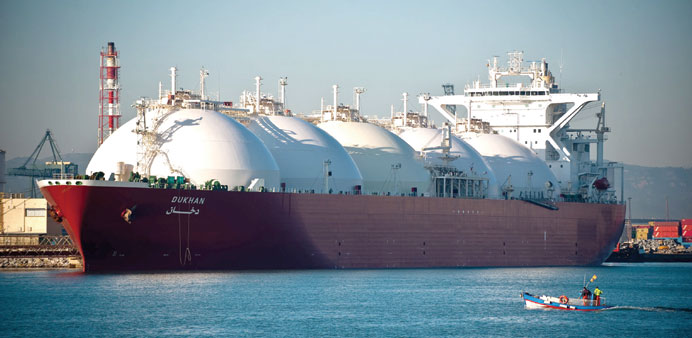The LNG vessel Dukhan is moored at the Enagas storage facility at the port of Barcelona (file). A 60% drop in Asian prices in the past year, driven by a streak of mild weather and new supplies, has again made Europe the most attractive market for flexible cargoes.
Reuters/Milan
Europe is attracting twice as many liquefied natural gas (LNG) tankers as last year and more are expected in what is now the premium-priced market after a year-long demand slump in Asia.
In just a week, seven new LNG tankers embarked for Belgian, British and Dutch ports and six more may arrive in the next month, attracted by the widest and most consistent premium to Asian prices in at least five years, price data on Reuters Eikon shows.
The shift signals an end to Asia’s huge LNG price premium to Europe’s benchmark UK gas hub, raising hopes that supply will over coming years be more evenly spread between the basins, traders said.
“We see NBP (UK natural gas prices) plus transportation returning as a price benchmark to Asia, at least for the next two to three years,” said Javier Moret, head of LNG origination at RWE, Germany’s biggest power utility.
More than 1.3mn cubic metres (mcm) of LNG, or 800 mcm of pipeline gas, is inbound on officially announced tankers from Qatar, Norway and Trinidad.
That’s double the same time last year and enough to cover three days of British winter demand.
At least six more tankers - the Zarga, Onaiza, Al Sadd, Ejnan and Al Ruwais - are expected to arrive in those ports during the next few weeks, according to analysts.
“Some trading companies are also trying to divert cargoes away from the east towards Europe,” a trader at an oil major said.
Asia has reigned as the world’s premium LNG market since Japan’s 2011 Fukushima disaster which shuttered the country’s nuclear plants, driving gas prices to near all-time highs.
But a 60% drop in Asian prices in the past year, driven by a streak of mild weather and new supplies, has again made Europe the most attractive market for flexible cargoes.
British and Dutch prices for March are trading at a $1.20 per million British thermal units (mmBtu) premium to Asia.
Plunging Far East prices are also trapping Atlantic Basin-produced LNG from Trinidad, Nigeria and Algeria within the region because it is no longer profitable to send it east.
Re-exports from countries such as Spain have also been brought to a halt for the first time in five years given weak demand around the globe.
One challenger to Europe for supply is India, where prices are also trading at premiums to Asia, albeit below those in Europe and the Americas.
Gazprom faces falling sales to Europe
Plunging sales to Europe and falling energy prices are not only sapping the revenue of Russia’s top natural gas producer Gazprom but also depriving the country’s budget of much-needed funds. Gazprom usually contributes almost one fifth of federal budget revenue, an amount the finance ministry would love to have this year as it tries to build up its resources to weather an economic crisis deepened by Western sanctions over Ukraine.
But a mild winter, better energy efficiency and a reluctance in Europe to take gas from Russia which is under European Union and US sanctions have meant some of the gas company’s main customers have halved their supplies.
And if prices stay low as they track oil, which has fallen almost 50% since mid-last year, Gazprom, and Russia, may lose billions of dollars. The price in Gazprom’s contracts is pegged to the oil price with a lag of six to nine months.
Sberbank CIB analyst Alex Fak said the budget may lose around $6bn a year if gas prices for Europe decline by 35% as expected, with possible sales falling by one third.

